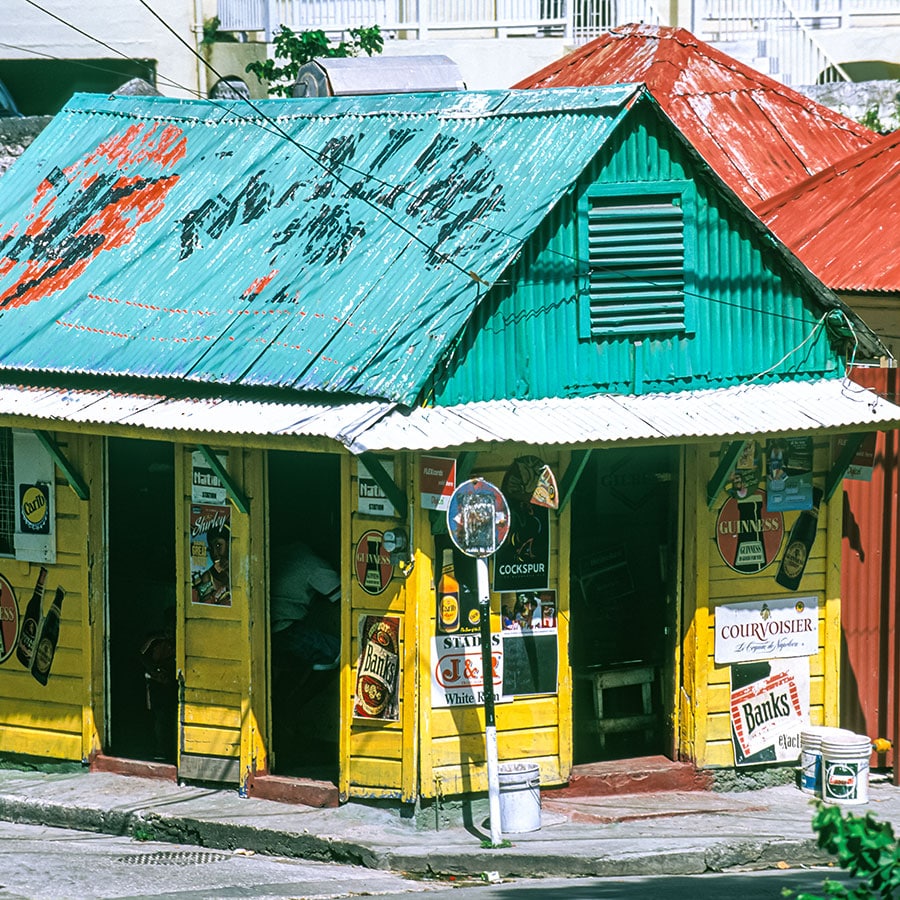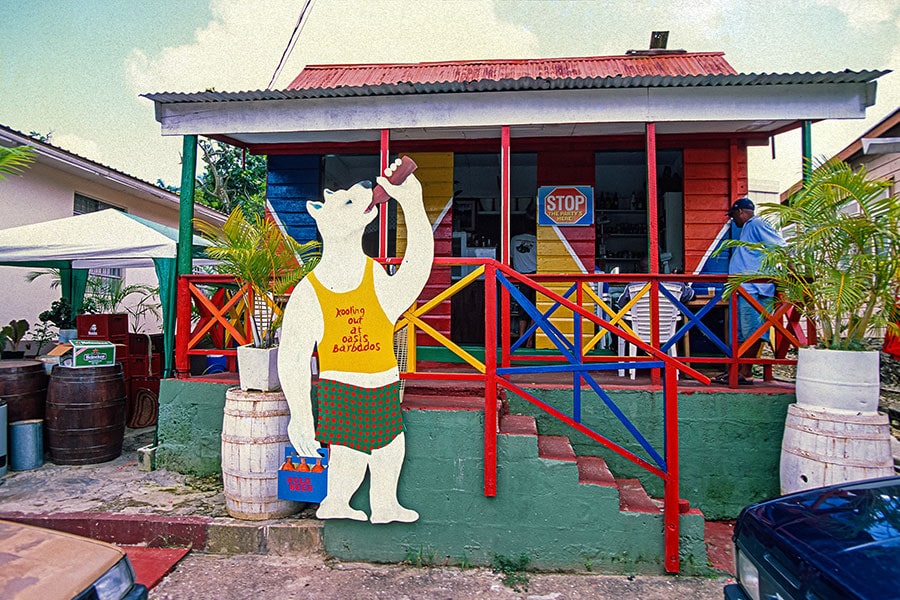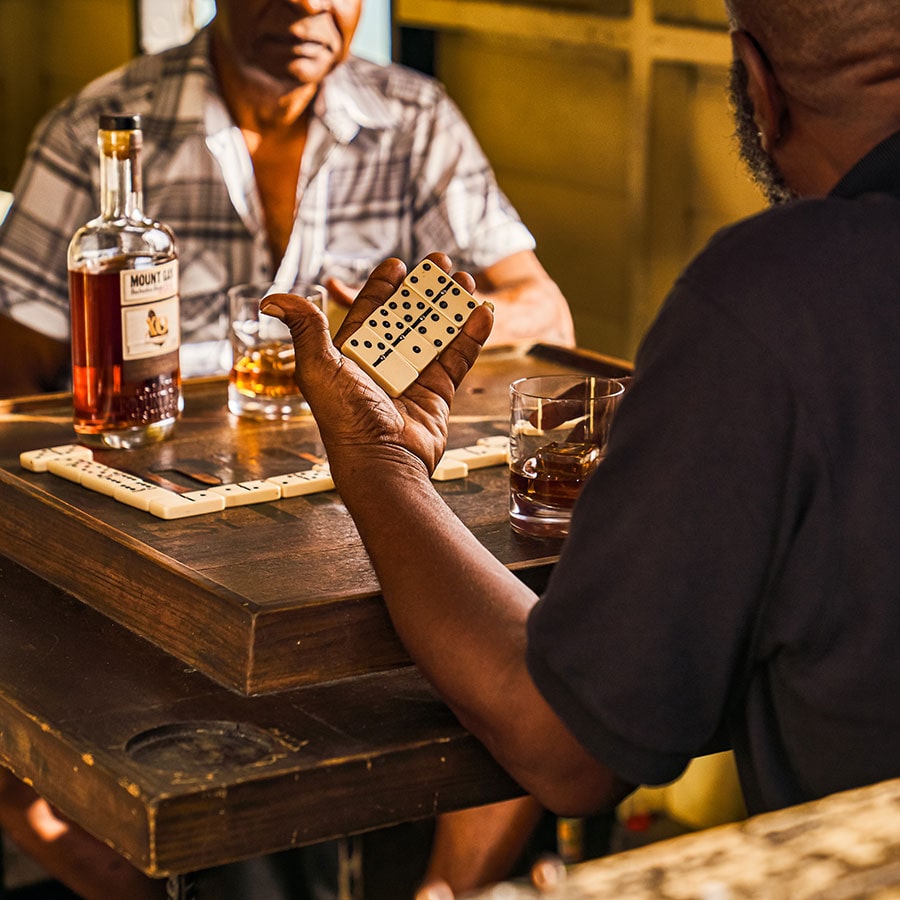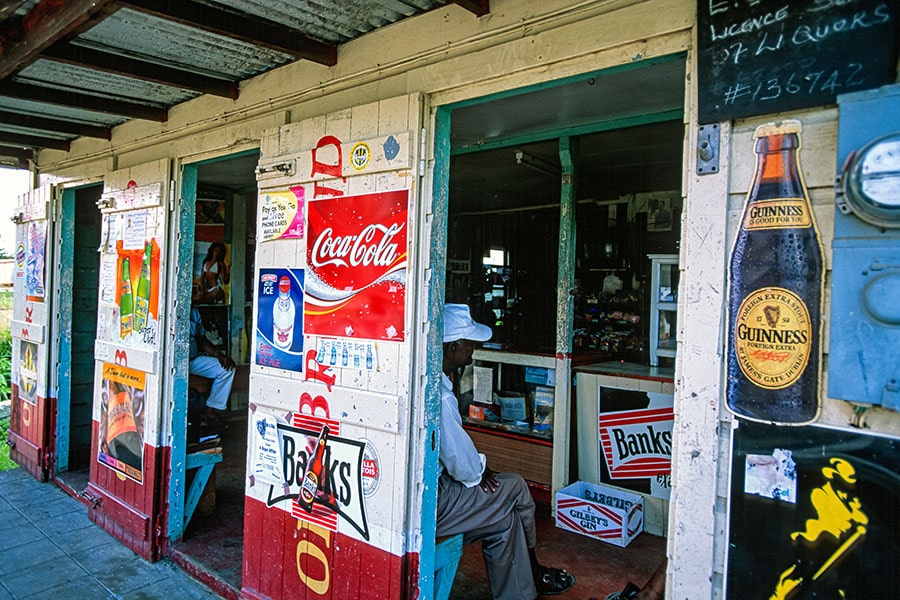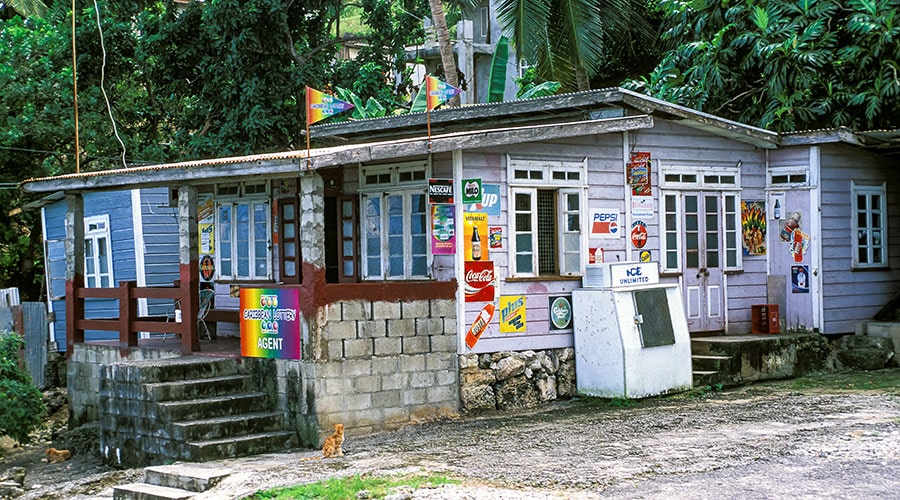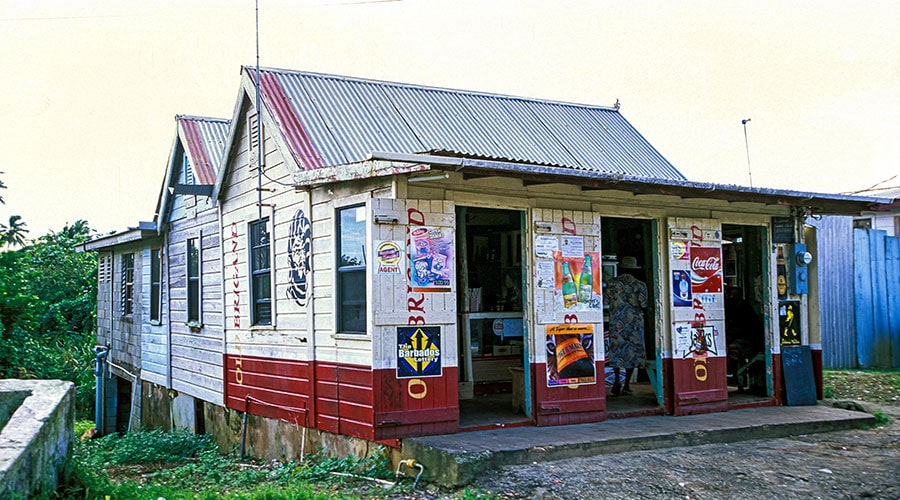“Pace yourself”… Quite an art! And an art that must be cultivated. In Barbados, the cradle of rum, it literally changes tempo. Drinking rum, chatting, looking at the sea… the Bajan people are masters of it. Rumporter takes you to the heart of the island’s rum shops, relics of an immemorial time.
©Mike Toy et Mount Gay
What does one look for on the most outlying island in the chain of the Lesser Antilles, with the Atlantic Ocean at its back? Its white sand beaches? Its turquoise waters? Its sunshine? A visit to the Mount Gay distillery, the oldest rum distillery in the world still in operation?
Of course, all of this, but don’t miss the rum shops, a unique way of life forged over the centuries by the communities that settled there and to whom we owe the birth of rum. The tricky art of idleness, distilled in these modest brick-and-mortar shops – Barbados has the most of them in the Caribbean, 1,600 according to official figures. The rum shops, which were distributed across the island’s eleven parishes, were the men’s meeting place on Sundays while their spouses went to mass…
How did they come to be? Why are they so enthralling? There is believed to be a rum shop for every church in Barbados. And this isn’t the only thing lacking on this 430-square-kilometer island, which is 34 kilometers long and 23 kilometers wide. One could even say that these two key institutions alone form the community hub of a typical Barbadian village.
In his book on rum shops*, Peter Laurie goes so far as to say: “Barbados is entirely devoted to the spiritual as well as to spirits. To trace their origins, we must go back to the 17th century. The English were the first to introduce the tippling houses, the ancestors of the pub in a way, which were already present in England, shortly after the island was officially invaded by the English in 1627.
“The Spaniards set up the churches, the Dutch the trading posts, the English the tippling houses…” Needless to say, alcohol flowed freely, especially rum, distilled without any license. On average, the white settlers drank a hundred liters a year, the free people of color a little less, and the slaves only about ten liters,” says Peter Laurie. That is to say, there was a lot of public disorder, and the government didn’t waste time getting involved and legislating about it.
It is only after 1834, date of the abolition of slavery, with the emergence of villages and small towns that rum shops, in the classical sense of the term – that is to say the association of a grocery store and a bar – would develop. Nearly 70 villages were created between 1850 and 1880. A figure to which we can add about sixty more during the first three decades of the 20th century.
These are the villages that form the fabric of the working class of the island and the breeding ground for the emergence of a black middle class. And with them came the emergence of the village grocery store, the core of an entire community. Street vendors began to sell from their homes, with transactions taking place through a side window, and even opened their own shops. Most were run by women, which is still the case today. It is this unique combination of a grocery store on one side and a tavern or bar on the other that constitutes the essence of a rum shop.
The owner’s sign is invariably accompanied by the words bar and grocery. On the one hand, the goods of first necessity, vital for the villagers, on the other hand, a place of meeting, in other words the point of pride of the social life of the village. The goods bought in bulk (potatoes, onions, sugar, corn flour, salted fish…) were weighed with the help of scales with trays and the fresh products, like cheese, bread, fish fritters, were put under a bell. These old scales and glass cloches can be found in some of the most authentic rum shops.
C’est cette combinaison unique d’épicerie d’un côté et de taverne ou bar de l’autre qui constitue l’essence même d’un rum shop. L’enseigne de son propriétaire s’accompagne d’ailleurs invariablement des mots bar et grocery. D’un côté les marchandises de première nécessité, vitales pour les villageois, de l’autre un lieu de rendez-vous, autrement dit le point d’orgue de la vie sociale du village.
Les marchandises achetées en gros (pommes de terre, oignons, sucre, farine de maïs, poissons salés…) étaient pesées à l’aide de balances à plateaux et les produits frais, comme le fromage, le pain, les beignets de poissons, mis sous cloche. On retrouve ces vieilles balances tout comme ces cloches en verre dans certains des rum shops les plus authentiques.
« Yuh can wan’it in de glass an’ dem bottle too » Bajan proverb
You can’t have your cake and eat it too
Drinks used to be measured in “jars” and you came with your own container. Today, rum is ordered at the counter by the bottle – mini (20 cl), flask (37.5 cl), or long neck (75 cl). The most “trained” drink it “pure” or “chase” it with water, soda, or a Banks beer – the Bajans’ favorite beer – at the top of the sales, so it’s no surprise that many rum businesses have been repainted in its colors, namely red, black, and white. Connoisseurs, on the other hand, match their rum with coconut water.
So does Trudiann Branker, master blender at Mount Gay, the first woman in Barbados to hold the position. “With a coconut water ice cube to be precise,” she confides. Rum businesses resemble modest wooden mobile homes in terms of architecture. Three front doors, generally sliding, an entrance porch, scrollwork as ornaments… they are reminiscent of a “miniature version” of a plantation house.
Inside, a large wooden counter occupies the entire width. The bulk of the goods were stored there. At the back, shelves, rum bottles lined up in tight rows, showing the color from the start.
A partition separated the bar from the rest of the shop, sometimes flanked by a small private room where the men of the village could sit, drink, play cards, compete in whist tournaments, play darts or dominoes.
They would talk about politics or cricket, or even village gossip, to stay up to speed, to share news, to learn about their neighbors… And when televisions were first introduced, they went there to watch them. Rum shops have even had, in their time, a role to play during electoral campaigns. In the midst of impromptu and anything but official meetings, one can easily envision the happy hubbub that must have prevailed there. But the main “occupation” was to do nothing, to literally let the time pass, drinking, talking, laughing… without any class boundaries. This is still the case.
This activity is intrinsic to the Caribbean culture. The locals are proud of it. That’s precisely what you’ll come to a rum shop for, something that totally escapes us Westerners, long since caught up with the noise and the fury. “Let’s go lime” or “let’s chill or hangout” are the expressions used. The bar could also be organized like a pub: the counter for the more modest, the back room for the more “respectable” members of the community. The living quarters were tucked away at the back.
Rum shops could also serve as “village banks”. Credit was granted. Everything was done orally and debts were paid when the pay was received. A system that had its limits, often obliging small shopkeepers to forbid it by posting messages such as “Credit granted to people over 90 years old, accompanied by their grandmother”, which was quite picturesque to say the least!
They were also used as canteens for school children. Often, long before the island was monopolized by the three big distilleries we know – Mount Gay (the oldest), West Indies and Foursquare, not to mention the little St. Nicholas Abbey, the rum drunk there was mostly made from blends or “vats” concocted in the back room from barrels bought in bulk and kept in 45-liter jean-dams.
Today, supermarkets have supplanted the small village grocery store. Many of them have gone out of business. Some are still used to help out, others have been converted into makeshift mini-markets, and still others are nothing more than bars. Billiards, darts, slot machines, video games, karaoke…
it is necessary to be up to date. And who says bar, often says restaurant. You can find there all the most exotic Bajan cuisine, barbecued chicken and pork, fried flying fish – the national symbol of Barbados – traditional dishes such as cou-cou (a mix of polenta and okra), rice and peas, pudding (sweet potato pudding) and souse (marinated pork), all of it with a lot of onions, peppers and spices…
It’s delicious and extremely cheap! The locals have their habits. They go there religiously on Fridays and Saturdays, rain or shine. The quality of the food and the atmosphere is a big part of it. Most of them have been repainted in bright colors, using the emblematic colors of this or that brand of beer, rum or other alcoholic beverage. Green, orange, and white for Malibu. Black, yellow and red for Guinness, pale yellow, white, and black for Mount Gay…
If we are witnessing today a proliferation of bars and restaurants reserved for tourists or a more affluent clientele, the rum shops are still there, for a simple and good reason: they have kept the humble part of their nature. And don’t get me wrong, but the distilleries rely on them for a large part of their sales! Finally, everyone can mingle.
The atmosphere is unpretentious, uninhibited and relaxed, sometimes noisy but always good-natured. The food is authentic and very inexpensive. The drinks are also a quarter of the price of the most fashionable bars. You meet fascinating people. In short, an experience that is priceless. Let’s recap?
“When you order your rum by the bottle, not by the glass
When ice is served in plastic
When a Banks beer costs two dollars or less
When you drink it by the bottle
When no one sips a glass of wine
When no one is there to serve you
When Bajan bread is served under a glass bell
When everyone’s talking at the top of their lungs
When old songs are playing on the jukebox
When the clatter of dominoes covers all the background noise
Then you know you’ve landed in a rum shop,” writes Peter Laurie in his book. Could this be the salt of life, the one that we must never stop gorging ourselves with, until we get drunk, in the shade of rickety shacks…?
TO READ
The Barbadian Rum Shop, The Other Watering Hole, by Peter Laurie (2001), published by Macmillan Caribbean.
TO SEE
A few rum shops that are worth a visit:
John Moore Bar. In the colors of Black Barrel, the essential vintage, with the XO, from the Mount Gay distillery, with its feet in the water.
Highway 1, West Coast, North part of the island.
Tyrone’s Bar. Behind Salt Ash Hotel, St. Lawrence Gap, southwestern part of the island.
Uncle Joe’s Bar & Grill. A favorite! Bathsheba.
Seaview. Great view of the bay! Above Uncle Joe’s, climbing a little.

